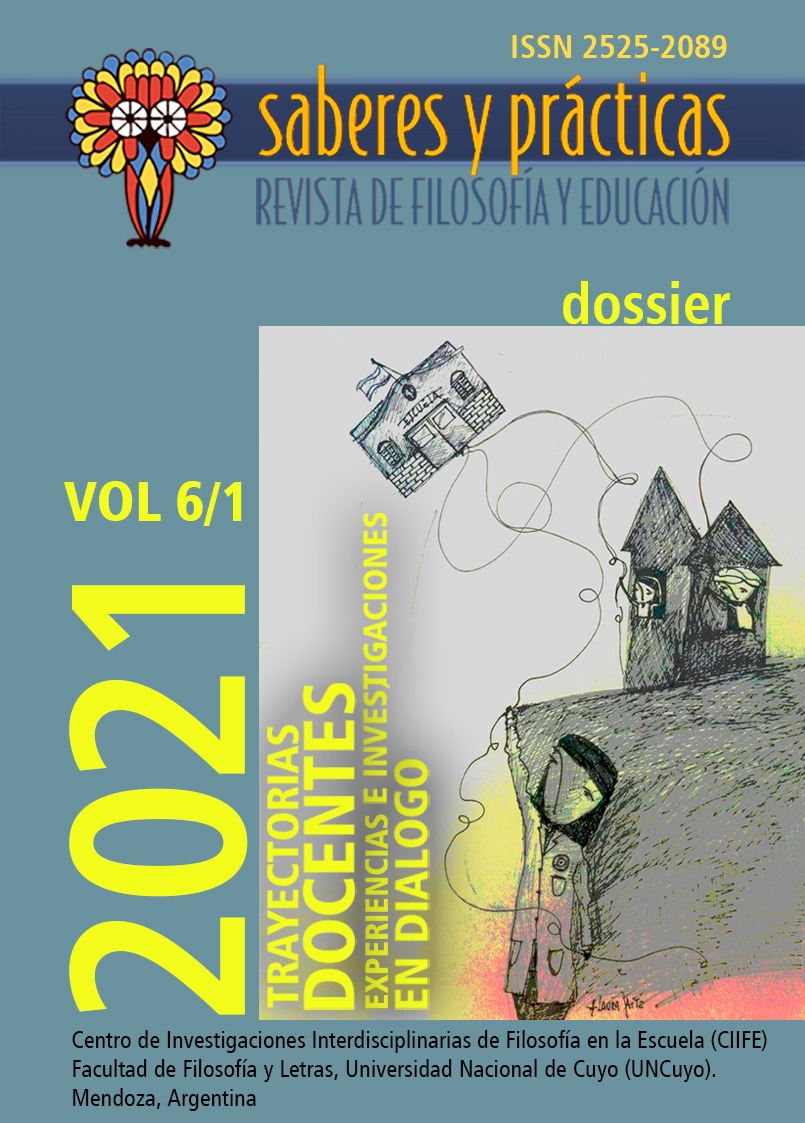Reproducibility of a didactic project on the acquisition of academic vocabulary in secondary school
DOI:
https://doi.org/10.48162/rev.36.025Keywords:
vocabulary, language instruction, teaching methods, educational projects, adolescenceAbstract
Previous research shows an important relationship between students’ ability to break down words into morphemes and their vocabulary acquisition skills. The aim of this study was to evaluate the reproducibility of a didactic project on word breakdown as a strategy to acquire vocabulary in ninth grade students. Participants consisted of an experimental group (26 students) whose morphological breakdown skills were compared in a pre and post-test to those of a control group (21 students). Results evidence an increase in the ability to segment words in the experimental group, even though there were no significant differences between groups in the ability to infer the meaning of morphologically complex words. A qualitative analysis of the productions of both the teacher and the students pointed out important factors to take into account when reproducing a didactic project of this kind in middle school.
Downloads
References
Anglin, J. (1993). “Vocabulary development: a morphological analysis”, Monographs of the Society for Research in Child Development, vol. LVIII, núm. 10, pp. 1-186.
Artigue, M. (2018), “Didáctica de las matemáticas y reproducibilidad”, Educación Matemática, vol. XXX, núm. 2, p. 9-32.
Bangs, K.; Binder, K. (2016). “Morphological awareness intervention: improving spelling, vocabulary, and reading comprehension for adult learners”, Journal of Research and Practice for Adult Literacy, Secondary, and Basic Education, vol. V, núm. 1, pp. 49-56.
Baumann, J. (2008), “Vocabulary and reading comprehension”, en Susan I.; Duffy, G. (eds.), Handbook of Research on Reading Comprehension. Routledge, pp. 323-346.
Baumann, J., Ware, D. y Edwards, E. (2007). “’Bumping into spicy, tasty words that catch your tongue’: a formative experiment in vocabulary instruction”, The Reading Teacher, vol. LXI, núm. 2, pp. 108-122.
Berman, R. y Nir, B. (2010). “The language of expository discourse across adolescence”, en Marilyn Nippold (ed.), Expository Discourse in Children, Adolescents, and Adults. Psychology Press, pp. 99-121.
Bowers, P., Kirby, J. y Deacon, H. (2010). “Review of educational research. The effects of morphological instruction on literacy skills: a systematic review of the literature”, American Educational Research Association, vol. LXXX, núm. 144, pp. 144-179.
Calsamiglia, H.; Tusón, A. (2007). Las cosas del decir: manual de análisis del discurso. Ariel.
Carlisle, J. (2004). “Morphological processes that influence learning to read” en Addison Stone, E.; Silliman, B.; Wallach, G. (eds.), Handbook of Language and Literacy Development and Disorders, E.E.U.U., Guilford, pp. 318-339.
Chamorro, M. (2005). Didáctica de las matemáticas para la educación infantil. Pearson.
Viana, P., Peruzzi, M.; Deacon, H. (2018). “Morphological awareness, word reading, and reading comprehension in Portuguese”, Applied Psycholinguistics, vol. XXXIX, núm. 3, pp. 507-525.
Dutro, S. y Moran, C. (2003). “Rethinking English language instruction: an architectural approach”. En Garcia, G. (ed.). English Learners: Researching the Highest Level of English Literacy, E.E.U.U., International Reading Association, pp. 1-38.
Godínez, M. (2019), El léxico en el dominio de la escritura académica, Tesis inédita de Doctorado, Querétaro, Universidad Autónoma de Querétaro (México).
Godínez, M.; Alarcón, L. (2018). “El léxico especializado como expresión de la competencia discursiva académica en ensayos producidos por jóvenes escolarizados en una clase de literatura”, en Bazerman, Ch. (comp.). Conocer la escritura: investigación más allá de las fronteras. Pontificia Universidad Javeriana/Writing Across the Curriculum Clearinghouse, pp. 155-180.
Gombert, J.E. (1992). Metalinguistic Development. University of Chicago Press.
González, R. (2014). Habilidades Lingüísticas de los estudiantes de primer ingreso a las instituciones de educación superior. ANUIES.
Goodwin, A., Petscher, Y.; Carlisle, J.; Mitchell, A. (2017). “Exploring the dimensionality of morphological knowledge for adolescent readers”, Journal of Research in Reading, vol. XL, núm. I, pp. 91-117.
Graves, M. (2006). The Vocabulary Book. Teachers College Press.
Hess, K. (2013a). “Desarrollo léxico en la adolescencia: un análisis de sustantivos en narraciones orales y escritas”, Actualidades en Psicología, vol. XXVII, núm. CXV, pp. 113-127.
Hess, K. (2013b). “¿Por qué es o no es narración?”. En Barriga, R. (ed.). Mitos y realidades del desarrollo lingüístico en la escuela. El Colegio de México. pp. 105-133.
Hess, K. (2018), “Desarrollo de la capacidad para reflexionar sobre la morfología de las palabras en los años escolares”. En Rojas, C. y Oropeza, E. (eds.). Diferencias individuales en la adquisición del lenguaje. Factores lingüísticos, cognitivos, socioambientales, México, Universidad Nacional Autónoma de México, pp. 253-293.
Hess, K. (2019). “Pensar sobre la morfología de las palabras: un proyecto didáctico para el desarrollo de vocabulario en la escuela secundaria”, Revista Iberoamericana de Evaluación Educativa, vol. XII, núm. II, pp. 193-215.
INEE (2016). Prueba Nacional Para la Evaluación de los Aprendizajes. Prueba PLANEA 2016. Lenguaje y Comunicación y Matemáticas. INEE.
Jaichenco, V.; Wilson, M. (2013). “El rol de la morfología en el proceso de aprendizaje de la lectura en español”, Interdisciplinaria, vol. XXX, núm. I, pp. 85-99.
Kelley, J., Lesaux, N., Kieffer, M. y Faller, E. (2010). “Effective academic vocabulary instruction in the urban middle school”, The Reading Teacher, vol. LXIV, núm. I, pp. 5-14.
Kieffer, M. y Lesaux, N. (2007). “Breaking down words to build meaning: morphology, vocabulary, and reading comprehension in the urban classroom”, The Reading Teacher, vol. LXI, núm. II, pp. 134-144.
Kieffer, M.; Lesaux, N. (2012). “Effects of academic language instruction on relational and syntactic aspects of morphological awareness for sixth graders from linguistically diverse backgrounds”, The Elementary School Journal, vol. CXII, núm. III, pp. 519-545.
Lane, H.; Gutlohn, L.; van Dijk, W. (2019). “Morpheme frequency in academic words: identifying high-utility morphemes for instruction”, Literacy Research and Instruction, vol. LVIII, núm. III, pp. 184-209.
Larsen, J.; Nippold, M. (2007), “Morphological analysis in school-age children: dynamic assessment of a word learning strategy”, Language, Speech, and Hearing Services in Schools, vol. XXXVIII, núm. III, pp. 201-212.
Lerner, D.; Torres, P.; Torres, M. (2009). Formación docente en lectura y escritura. Recorridos didácticos.Paidós.
Lezama, F. (2003). Un estudio de reproducibilidad de situaciones didácticas, Tesis inédita de Doctorado, México, Centro de Investigación y Estudios Avanzados del Instituto Politécnico Nacional (México).
Lezama, F. (2005). “Una mirada socioepistemológica al fenómeno de la reproducibilidad”, Relime, vol. VIII, núm. 3, pp. 339-362.
Lezama, F.; Farfán, R. (2001). “Introducción al estudio de la reproducibilidad”, Revista Latinoamericana de Investigación en Matemática Educativa, vol. IV, núm. 2, pp. 161-193.
Mahony, Diana, Singson, Maria y Mann, Virginia (2000), “Reading ability and sensitivity to morphological relations”, Reading and Writing: An Interdisciplinary Journal, vol. XII, núm. III-IV, pp. 191-218.
Martín, R. (2018). “Modelos de aprendizaje léxico basados en la morfología derivativa”, RILCE, vol. XXXIV, núm. I, pp. 262-285.
Metsala, J., Parrila; Rauno, C.; Nicole y Deacon, H. (2019). “Morphological awareness and reading achievement in university students”, Applied Psycholinguistics, vol. XL, núm. III, pp. 743-763.
Montoya, M. S.; Lezama, F. (2016). “La reproducibilidad de situaciones de aprendizaje en un taller de reflexión docente”, Cuadernos de Investigación Educativa, vol. VII, núm. 1, pp. 41-54.
Nagy, W. y Townsend, D. (2012). “Words as tools: learning academic vocabulary as language acquisition”, Reading Research Quarterly, vol. XLVII, núm. I, pp. 91-108.
Nippold, M. (2016). Later Language Development: School Age Children, Adolescents and Young Adults. Pro-Ed.
Nippold, M.; Scott, Ch. (2010). Expository Discourse in Children, Adolescents, and Adults: Development and Disorders. Psychology Press.
Nippold, M.; Sun, L. (2008). “Knowledge of morphologically complex words: A developmental study of older children and young adolescents”, Language, Speech, and Hearing Services in Schools, vol. XXXIX, pp. 365-373.
Pacheco, M.; Goodwin, A. (2013). “Putting two and two together: middle school students’ morphological problem-solving strategies for unknown words”, Journal of Adolescent y Adult Literacy, vol. LVI, núm. VII, pp. 541-553.
Pastor, S. (2004). “El papel de la reflexión metalingüística en la adquisición de la gramática de E/LE” en ASELE (ed.), Actas del XV Congreso Internacional de ASELE: Las gramáticas y los diccionarios en la enseñanza del español como segunda lengua, España, ASELE, pp. 638-645.
Rojas, M. (2006), “Esbozo de lineamientos conceptuales para la enseñanza y aprendizaje del léxico”, Revista Educación, vol. XXX, núm. II, pp. 9-29.
Scribner, S. y Cole, M. (1978), “Unpacking literacy”, Social Science Information, vol. XVII, núm. I, pp. 57-71.
Schleppegrell, M. J. (2004). The Language of Schooling: A Functional Linguistics Perpective. Mahwah NJ: Lawrence Erlbaum.
Snow, C.; Uccelli, P. (2009). “The challenge of academic language” en Olson, D.; Torrance, N. (eds.). The Cambridge Handbook of Literacy. Cambridge University Press, pp. 112-133.
Snow, C.; Uccelli, P. (2014). “Más allá de la narrativa: aprendiendo otros discursos necesarios para la escuela”. En Barriga, R. (ed.), Las narrativas y su impacto en el desarrollo lingüístico infantil. El Colegio de México, pp. 749-763.
Snyder, L. y Caccamise, D. (2010), “Comprehension processes for expository text: building meaning and making sense”. En Marilyn N.; Scott, Ch. (eds.). Expository Discourse in Children, Adolescents, and Adults, E.E.U.U., Psychology Press, pp. 13-39.
Sparks, E. y Deacon, H. (2013). “Morphological awareness and morphological acquisition: a longitudinal examination of their relationship in English-speaking children”, Applied Psycholinguistics, vol. XXXVI, pp. 299-321.
St. John, P. y Vance, M. (2014). “Evaluation of a principled approach to vocabulary learning in mainstream classes”, Child Language Teaching and Therapy, vol. XXX, núm. III, pp. 255-271.
Stahl, S. (1999). Vocabulary development. Brookline Books.
Tighe, E.; Binder, K. (2015). “An investigation of morphological awareness and processing in adults with low literacy”, Applied Psycholinguistics, vol. XXXVI, pp. 245-273.
Tighe, E.; Fernandes, M. (2019). “Unraveling the complexity of the relations of metalinguistic skills to word reading with struggling adult readers: shared, independent and interactive effects”, Applied Psycholinguistics, vol. XL, núm. III, pp. 765-793.
Tyler, A.; Nagy, W. (1989). “The acquisition of English derivational morphology”, Journal of Memory and Language, vol. XXVIII, núm. VI, pp. 649-667.
Uccelli, P., Dobbs, Ch.; Scott, J. (2012). “Mastering academic language: organization and stance in the persuasive writing of high school students”, Written Communication, vol. XXX, núm. I, pp. 36-62.
Zwiers, J. (2008). Building academic language: essential practices for content classrooms. Jossey Bass.
Published
How to Cite
Issue
Section
License
License
This work is licensed under a Creative Commons Attribution-NonCommercial-ShareAlike 2.5 Argentina License.





















